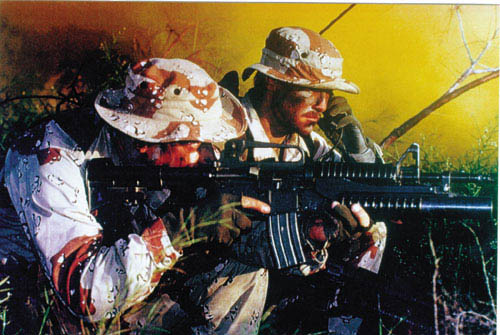Care
of Blast Injuries Under Fire
Primary Problem:
Casualty
unable to help himself while he and teammates are under fire
Secondary Problems:
-
Unconsciousness
due to vagal reflexes or arterial gas embolism
-
Traumatic
amputations in casualties close to detonation point
-
Penetrating
trauma from fragments, shrapnel, and miscellaneous debris
-
Blunt
trauma from casualty being displaced by blast wind
Introduction:
Most
casualties within the injury radius of high-explosive (HE)
detonation will have common penetrating, blunt, and burn injuries managed
no differently than similar non-blast trauma. Although blast overpressure can also cause occult
injuries to intra-thoracic and intra-abdominal organs, these are not
immediately important when personnel are under effective hostile fire.
Movement Under Fire
Should you or teammate move from
position of cover to attend or retrieve casualty?
(Predetermined hand signals may be used to communicate with
conscious casualties. Binoculars
may help assess unconscious casualties from concealed site.)
Focused Questions (if
attend casualty)
 Quantity
– Quantity
–
-
Where
does it hurt?
(May help identify location of wounds with potentially
exsanguinating external hemorrhage.)
-
Can
you breathe OK?
(Chest injuries may be managed when in Tactical Field
Care, so
degree of respiratory difficulty may help decide urgency of movement
to cover.)
Quality
–
Objective
Using Basic Tools
General:
Inspection:
-
Identify
sites of life-threatening external hemorrhage first.
-
Traumatic
amputation and penetrating vascular injury are common in
casualties close to blasts. May
range from tips of digits to entire limbs, but volume of bleeding is
critical parameter.
Auscultation:
Palpation:
Assessment
Rapid Decision-Making
-
Significant
respiratory distress and external hemorrhage are only
medical reasons for going to casualty, but risks to personnel must be
weighed against risks to mission accomplishment if injured or killed.
-
Possibility
of additional injury to casualty (lack of cover during firefight,
drawing enemy attention by movement) is also consideration.
-
Unconsciousness
alone is not a reason to expose additional personnel to danger.
-
If
there is no respiratory distress or arrest, the casualty’s airway is
temporarily intact.
-
Vasovagal
syncope
will resolve on its own.
-
Penetrating
head and torso trauma, arterial gas embolism (AGE), and seizures
cannot be managed under fire.
Differential Diagnosis
Plan
Immediate Actions
-
Essential:
Return fire as directed or required.
Take cover or otherwise prevent injury to additional personnel.
Don chemical-biological-radiological (CBR) protection, if
appropriate.
-
Recommended:
Make
tactical decision whether or not to have casualty move to cover or
have other personnel attempt retrieval of casualty.
Procedures
Notes
-
“The
best medicine on the battlefield is fire superiority.”
Casualties may receive additional wounds and uninjured
personnel may become casualties, if not behind cover during hostile
fire.
-
Very
little treatment can be accomplished until transition into Tactical
Field Care.
-
AMS
is most likely due to penetrating or blunt head trauma or shock from
bleeding, but two unique features of blast injury are less common
causes:
-
Blast
overpressure on lungs can cause vasovagal syncope with
bradycardia and hypotension, which may last minutes to hours even
with conventional treatment.
-
Stress-induced
tears in lung tissue may allow air into pulmonary veins, which can
then be ejected to cerebral (stroke) or coronary circulation
(heart attack).
-
If
AGE is suspected, place in coma position with left side down
(halfway between left-lateral decubitus and prone) and head at same
level as heart.
This section contributed by Lt Col John Wightman, USAF, MC
|
|
Approved for public release;
Distribution is unlimited.
The listing of any non-Federal product in this CD is not an endorsement of the
product itself, but simply an acknowledgement of the source.
Bureau of Medicine and Surgery
Department of the Navy
2300 E Street NW
Washington, D.C
20372-5300 |
Operational Medicine
Health Care in Military Settings
CAPT Michael John Hughey, MC, USNR
NAVMED P-5139
January 1, 2001 |
United States Special Operations
Command
7701 Tampa Point Blvd.
MacDill AFB, Florida
33621-5323 |
*This web version is provided by
The Brookside Associates Medical Education Division. It contains
original contents from the official US Navy NAVMED P-5139, but has been
reformatted for web access and includes advertising and links that were not
present in the original version. This web version has not been approved by the
Department of the Navy or the Department of Defense. The presence of any
advertising on these pages does not constitute an endorsement of that product or
service by either the US Department of Defense or the Brookside Associates. The
Brookside Associates is a private organization, not affiliated with the United
States Department of Defense.
Contact Us · · Other
Brookside Products

|
|
Operational Medicine 2001
Contents
|

|




